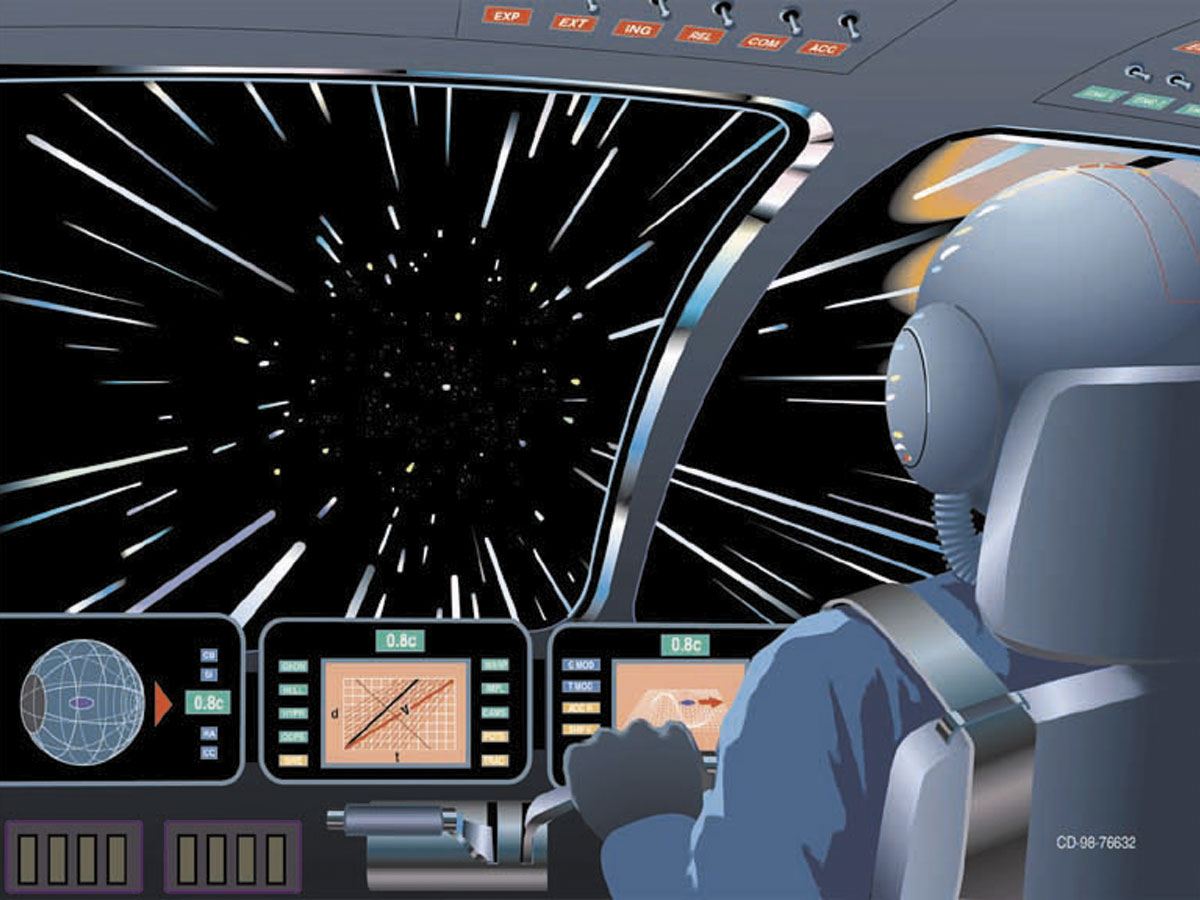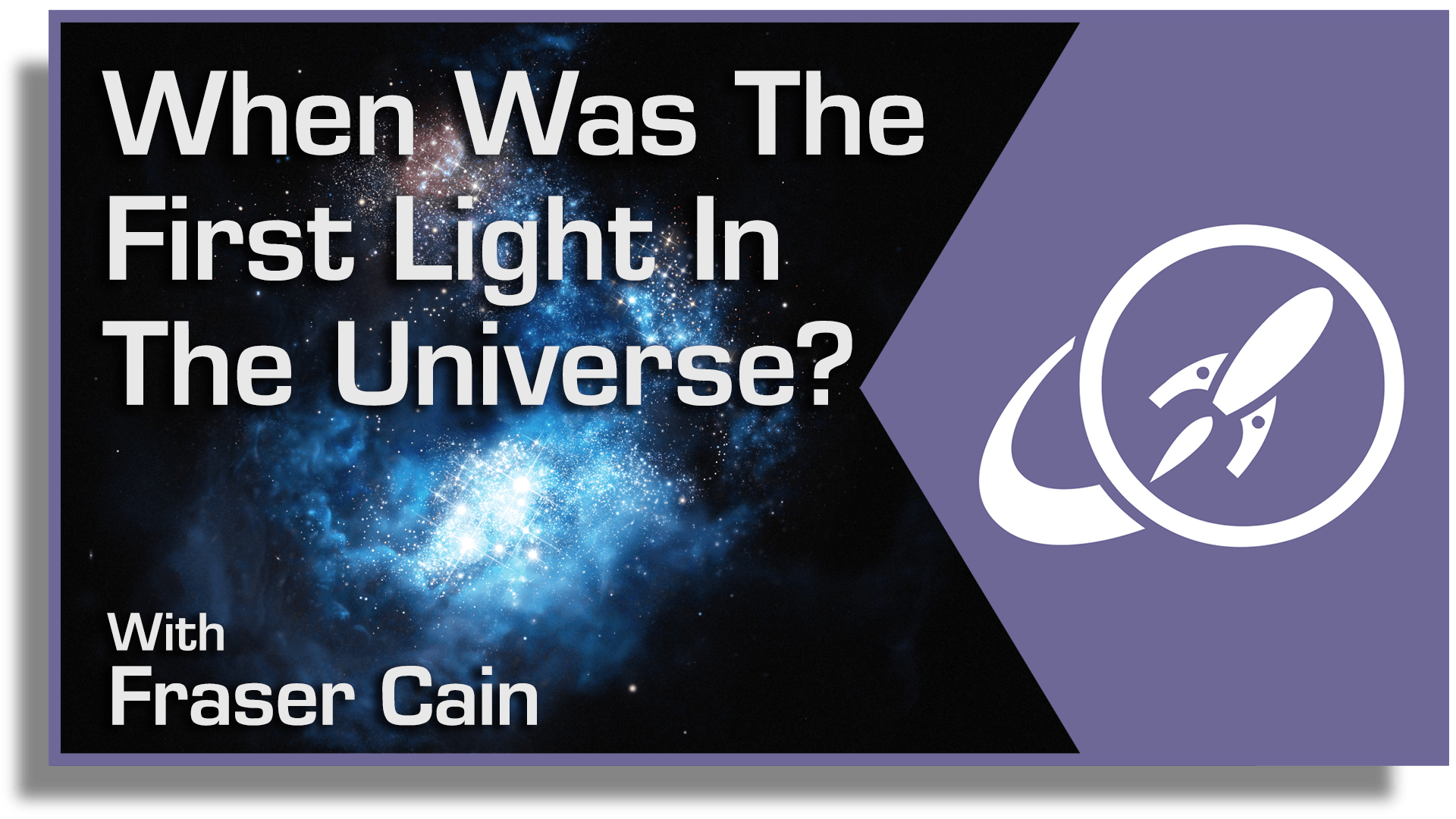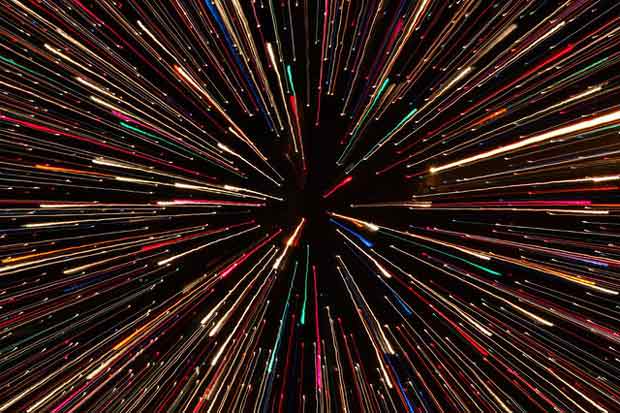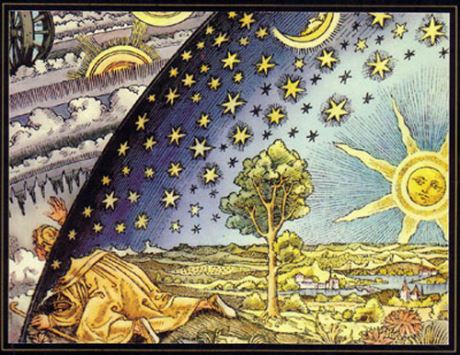Special relativity is one of the most strongly validated theories humanity has ever devised. It is central to everything from space travel and GPS to our electrical power grid. Central to relativity is the fact that the speed of light in a vacuum is an absolute constant. The problem is, that fact has never been proven.
Continue reading “There's no way to Measure the Speed of Light in a Single Direction”M87’s Black Hole is Firing Out Jets that Travel 99% the Speed of Light
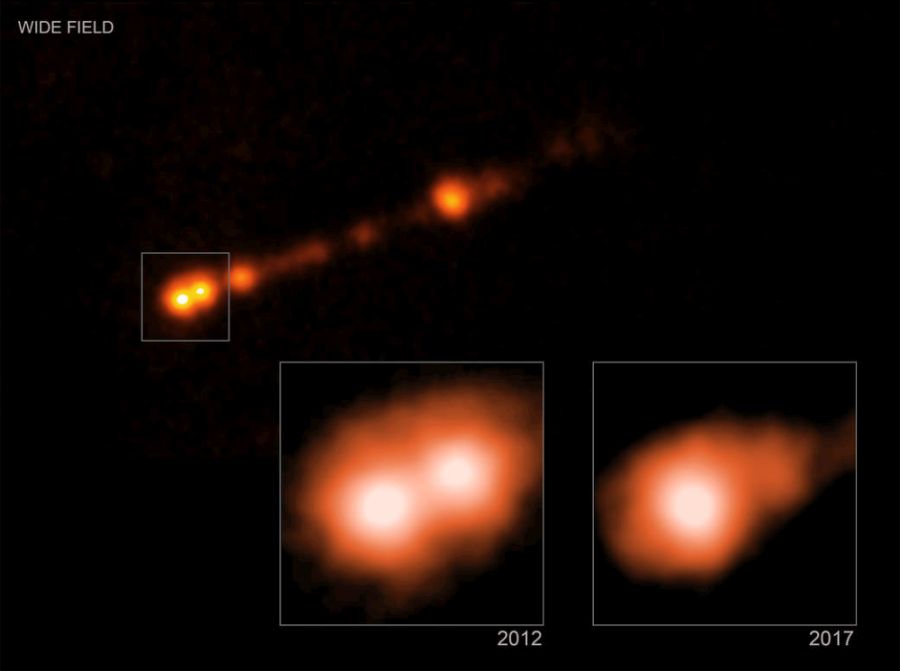
Can black holes be famous? If they can, then the one at the heart of the M87 galaxy qualifies. And this famous black hole is emitting jets of material that travel at near the speed of light.
Continue reading “M87’s Black Hole is Firing Out Jets that Travel 99% the Speed of Light”How Far Does Light Travel in a Year?

The Universe is an extremely big place. As astronomers looked farther into space over the centuries, and deeper into the past, they came to understand just how small and insignificant our planet and our species seem by comparison. At the same time, ongoing investigations into electromagnetism and distant stars led scientists to deduce what the the speed of light is – and that it is the fastest speed obtainable.
As such, astronomers have taken to using the the distance light travels within a single year (aka. a light year) to measure distances on the interstellar and intergalactic scale. But how far does light travel in a year? Basically, it moves at a speed of 299,792,458 meters per second (1080 million km/hour; 671 million mph), which works out to about 9,460.5 trillion km (5,878.5 trillion miles) per year.
The Speed of Light:
Calculating the speed of light has been a preoccupation for scientists for many centuries. And prior to the 17th century, there was disagreement over whether the speed of light was finite, or if it moved from one spot to the next instantaneously. In 1676, Danish astronomer Ole Romer settled the argument when his observations of the apparent motion of Jupiter’s moon Io revealed that the speed of light was finite.
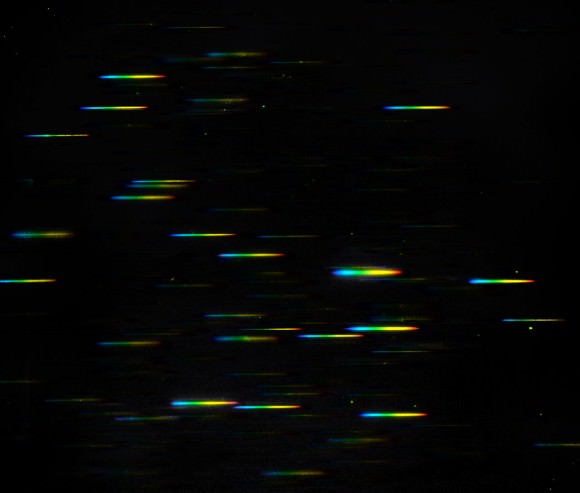
From his observations, famed Dutch astronomer Christiaan Huygens calculated the speed of light at 220,000 km/s (136,701 mi/s). Over the course of the nest two centuries, the speed of light was refined further and further, producing estimates that ranged from about 299,000 to 315,000 km/s (185,790 to 195,732 mi/s).
This was followed by James Clerk Maxwell, who proposed in 1865 that light was an electromagnetic wave. In his theory of electromagnetism, the speed of light was represented as c. And then in 1905, Albert Einstein proposed his theory of Special Relativity, which postulated that the speed of light (c) was constant, regardless of the inertial reference frame of the observer or the motion of the light source.
By 1975, after centuries of refined measurements, the speed of light in a vacuum was calculated at 299,792,458 meters per second. Ongoing research also revealed that light travels at different wavelengths and is made up of subatomic particles known as photons, which have no mass and behave as both particles and waves.
Light-Year:
As already noted, the speed of light (expressed in meters per second) means that light travels a distance of 9,460,528,000,000 km (or 5,878,499,817,000 miles) in a single year. This distance is known as a “light year”, and is used to measure objects in the Universe that are at a considerable distances from us.

For example, the nearest star to Earth (Proxima Centauri) is roughly 4.22 light-years distant. The center of the Milky Way Galaxy is 26,000 light-years away, while the nearest large galaxy (Andromeda) is 2.5 million light-years away. To date, the candidate for the farthest galaxy from Earth is MACS0647-JD, which is located approximately 13.3 billion light years away.
And the Cosmic Microwave Background, the relic radiation which is believed to be leftover from the Big Bang, is located some 13.8 billion light years away. The discovery of this radiation not only bolstered the Big Bang Theory, but also gave astronomers an accurate assessment of the age of the Universe. This brings up another important point about measuring cosmic distances in light years, which is the fact that space and time are intertwined.
You see, when we see the light coming from a distant object, we’re actually looking back in time. When we see the light from a star located 400 light-years away, we’re actually seeing light that was emitted from the star 400 years ago. Hence, we’re seeing the star as it looked 400 years ago, not as it appears today. As a result, looking at objects billions of light-years from Earth is to see billions of light-years back in time.
Yes, light travels at an extremely fast speed. But given the sheer size and scale of the Universe, it can still take billions of years from certain points in the Universe to reach us here on Earth. Hence why knowing how long it takes for light to travel a single year is so useful to scientists. Not only does it allow us to comprehend the scale of the Universe, it also allows us to chart the process of cosmic evolution.
We have written many articles about the speed of light here at Universe Today. Here’s How Far is a Light Year?, What is the Speed of Light?, How Much Stuff is in a Light Year?, How Does Light Travel?, and How Far Can You See in the Universe?
Want more info on light-years? Here’s an article about light-years for HowStuffWorks, and here’s an answer from PhysLink.
We’ve also recorded an episode of Astronomy Cast on this topic. Listen here, Episode 10: Measuring Distance in the Universe.
Sources:
Finite Light — Why We Always Look Back In Time

My attention was focused on beaded water on a poplar leaf. How gemmy and bursting with the morning’s sunlight. I moved closer, removed my glasses and noticed that each drop magnified a little patch of veins that thread and support the leaf.
Focusing the camera lens, I wondered how long it took the drops’ light to reach my eye. Since I was only about six inches away and light travels at 186,000 miles per second or 11.8 inches every billionth of a second (one nanosecond), the travel time amounted to 0.5 nanoseconds. Darn close to simultaneous by human standards but practically forever for positronium hydride, an exotic molecule made of a positron, electron and hydrogen atom. The average lifetime of a PsH molecule is just 0.5 nanoseconds.

In our everyday life, the light from familiar faces, roadside signs and the waiter whose attention you’re trying to get reaches our eyes in nanoseconds. But if you happen to look up to see the tiny dark shape of a high-flying airplane trailed by the plume of its contrail, the light takes about 35,000 nanoseconds or 35 microseconds to travel the distance. Still not much to piddle about.
The space station orbits the Earth in outer space some 250 miles overhead. During an overhead pass, light from the orbiting science lab fires up your retinas 1.3 milliseconds later. In comparison, a blink of the eye lasts about 300 milliseconds (1/3 of a second) or 230 times longer!
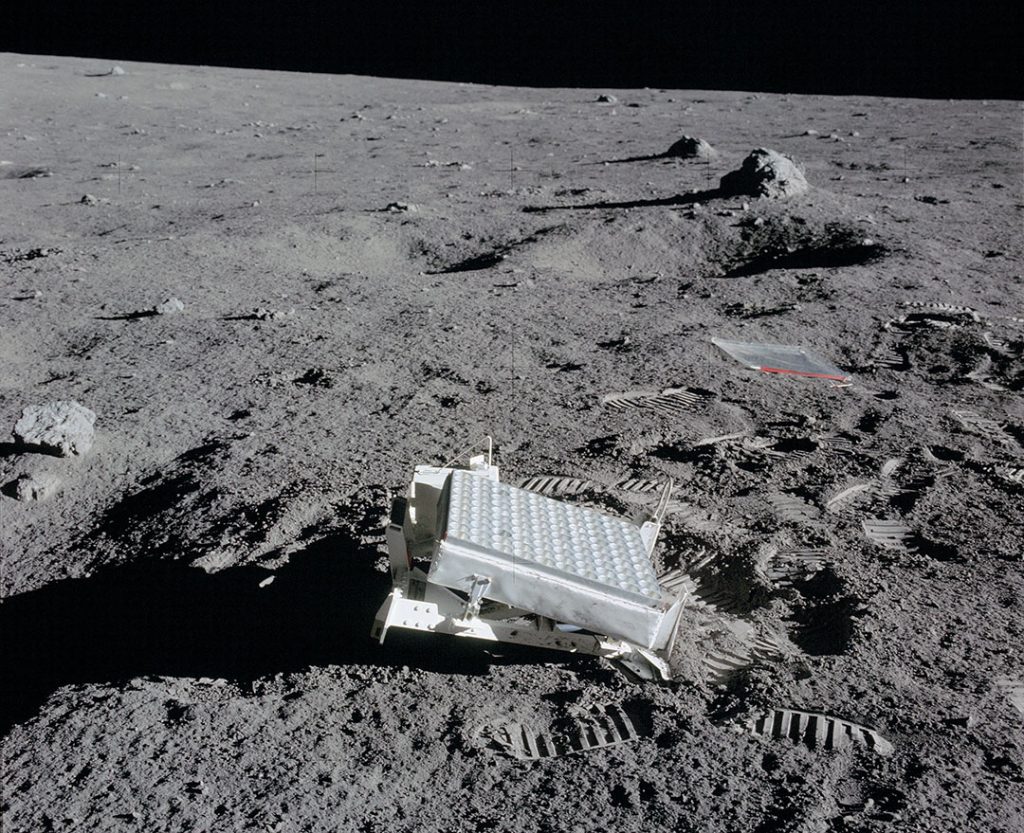
Light time finally becomes more tangible when we look at the Moon, a wistful 1.3 light seconds away at its average distance of 240,000 miles. To feel how long this is, stare at the Moon at the next opportunity and count out loud: one one thousand one. Retroreflecting devices placed on the lunar surface by the Apollo astronauts are still used by astronomers to determine the moon’s precise distance. They beam a laser at the mirrors and time the round trip.
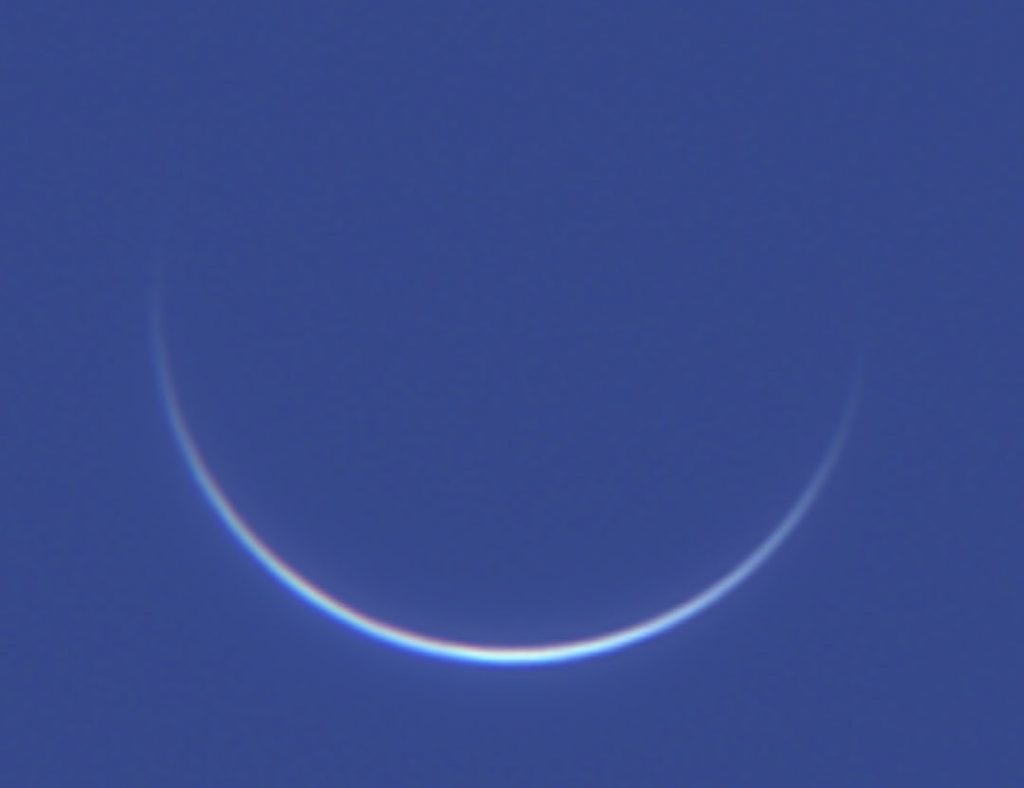
Of the eight planets, Venus comes closest to Earth, and it does so during inferior conjunction, which coincidentally occurred on March 25. On that date only 26.1 million miles separated the two planets, a distance amounting to 140 seconds or 2.3 minutes — about the time it takes to boil water for tea. Mars, another close-approaching planet, currently stands on nearly the opposite side of the Sun from Earth.
With a current distance of 205 million miles, a radio or TV signal, which are both forms of light, broadcast to the Red Planet would take 18.4 minutes to arrive. Now we can see why engineers pre-program a landing sequence into a Mars’ probe’s computer to safely land it on the planet’s surface. Any command – or change in commands – we might send from Earth would arrive too late. Once a lander settles on the planet and sends back telemetry to communicate its condition, mission control personnel must bite their fingernails for many minutes waiting for light to limp back and bring word.
Before we speed off to more distant planets, let’s consider what would happen if the Sun had a catastrophic malfunction and suddenly ceased to shine. No worries. At least not for 8.3 minutes, the time it takes for light, or the lack of it, to bring the bad news.

Light from Jupiter takes 37 minutes to reach Earth; Pluto and Charon are so remote that a signal from the “double planet” requires 4.6 hours to get here. That’s more than a half-day of work on the job, and we’ve only made it to the Kuiper Belt.
Let’s press on to the nearest star(s), the Alpha Centauri system. If 4.6 hours of light time seemed a long time to wait, how about 4.3 years? If you think hard, you might remember what you were up to just before New Year’s Eve in 2012. About that time, the light arriving tonight from Alpha Centauri left that star and began its earthward journey. To look at the star then is to peer back in time to late 2012.
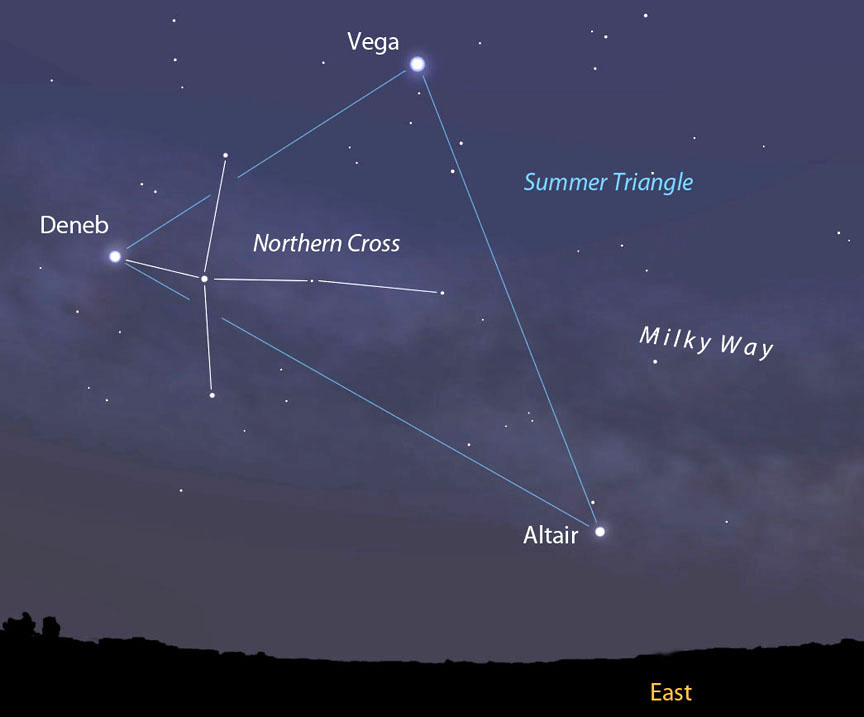
But we barely scrape the surface. Let’s take the Summer Triangle, a figure that will soon come to dominate the eastern sky along with the beautiful summer Milky Way that appears to flow through it. Altair, the southernmost apex of the triangle is nearby, just 16.7 light years from Earth; Vega, the brightest a bit further at 25 and Deneb an incredible 3,200 light years away.
We can relate to the first two stars because the light we see on a given evening isn’t that “old.” Most of us can conjure up an image of our lives and the state of world affairs 16 and 25 years ago. But Deneb is exceptional. Photons departed this distant supergiant (3,200 light years) around the year 1200 B.C. during the Trojan War at the dawn of the Iron Age. That’s some look-back time!

One of the most distant naked eye stars is Rho Cassiopeiae, yellow variable some 450 times the size of the Sun located 8,200 light years away in the constellation Cassiopeia. Right now, the star is near maximum and easy to see at nightfall in the northwestern sky. Its light whisks us back to the end of the last great ice age at a time and the first cave drawings, more than 4,000 years before the first Egyptian pyramid would be built.

On and on it goes: the nearest large galaxy, Andromeda, lies 2.5 million light years from us and for many is the faintest, most distant object visible with the naked eye. To think that looking at the galaxy takes us back to the time our distant ancestors first used simple tools. Light may be the fastest thing in the universe, but these travel times hint at the true enormity of space.
Let’s go a little further. On November 16, 1974 a digital message was beamed from the Arecibo radio telescope in Puerto Rico to the rich star cluster M13 in Hercules 25,000 light years away. The message was created by Dr. Frank Drake, then professor of astronomy at Cornell, and contained basic information about humanity, including our numbering system, our location in the solar system and the composition of DNA, the molecule of life. It consisted of 1,679 binary bits representing ones and zeroes and was our first deliberate communication sent to extraterrestrials. Today the missive is 42 light years away, just barely out the door.

Let’s end our time machine travels with the most distant object we’ve seen in the universe, a galaxy named GN-z11 in Ursa Major. We see it as it was just 400 million years after the Big Bang (13.4 billion years ago) which translates to a proper distance from Earth of 32 billion light years. The light astronomers captured on their digital sensors left the object before there was an Earth, a Solar System or even a Milky Way galaxy!
 Thanks to light’s finite speed we can’t help but always see things as they were. You might wonder if there’s any way to see something right now without waiting for the light to get here? There’s just one way, and that’s to be light itself.
Thanks to light’s finite speed we can’t help but always see things as they were. You might wonder if there’s any way to see something right now without waiting for the light to get here? There’s just one way, and that’s to be light itself.
From the perspective of a photon or light particle, which travels at the speed of light, distance and time completely fall away. Everything happens instantaneously and travel time to anywhere, everywhere is zero seconds. In essence, the whole universe becomes a point. Crazy and paradoxical as this sounds, the theory of relativity allows it because an object traveling at the speed of light experiences infinite time dilation and infinite space contraction.
Just something to think about the next time you meet another’s eyes in conversation. Or look up at the stars.
When Was the First Light in the Universe?
The speed of light gives us an amazing tool for studying the Universe. Because light only travels a mere 300,000 kilometers per second, when we see distant objects, we’re looking back in time.
You’re not seeing the Sun as it is today, you’re seeing an 8 minute old Sun. You’re seeing 642 year-old Betelgeuse. 2.5 million year-old Andromeda. In fact, you can keep doing this, looking further out, and deeper into time. Since the Universe is expanding today, it was closer in the past.
Run the Universe clock backwards, right to the beginning, and you get to a place that was hotter and denser than it is today. So dense that the entire Universe shortly after the Big Bang was just a soup of protons, neutrons and electrons, with nothing holding them together.
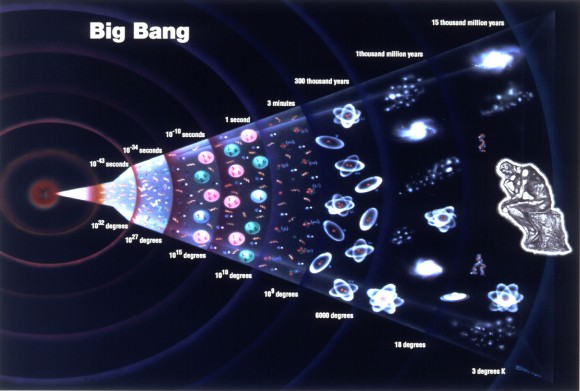
In fact, once it expanded and cooled down a bit, the entire Universe was merely as hot and as dense as the core of a star like our Sun. It was cool enough for ionized atoms of hydrogen to form.
Because the Universe has the conditions of the core of a star, it had the temperature and pressure to actually fuse hydrogen into helium and other heavier elements. Based on the ratio of those elements we see in the Universe today: 74% hydrogen, 25% helium and 1% miscellaneous, we know how long the Universe was in this “whole Universe is a star” condition.
It lasted about 17 minutes. From 3 minutes after the Big Bang until about 20 minutes after the Big Bang. In those few, short moments, clowns gathered all the helium they would ever need to haunt us with a lifetime of balloon animals.
The fusion process generates photons of gamma radiation. In the core of our Sun, these photons bounce from atom to atom, eventually making their way out of the core, through the Sun’s radiative zone, and eventually out into space. This process can take tens of thousands of years. But in the early Universe, there was nowhere for these primordial photons of gamma radiation to go. Everywhere was more hot, dense Universe.
The Universe was continuing to expand, and finally, just a few hundred thousand years after the Big Bang, the Universe was finally cool enough for these atoms of hydrogen and helium to attract free electrons, turning them into neutral atoms.
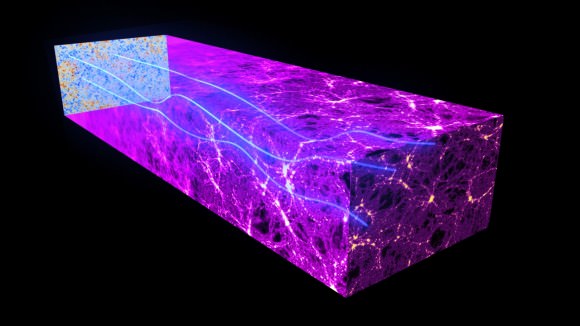
This was the moment of first light in the Universe, between 240,000 and 300,000 years after the Big Bang, known as the Era of Recombination. The first time that photons could rest for a second, attached as electrons to atoms. It was at this point that the Universe went from being totally opaque, to transparent.
And this is the earliest possible light that astronomers can see. Go ahead, say it with me: the Cosmic Microwave Background Radiation. Because the Universe has been expanding over the 13.8 billion years from then until now, the those earliest photons were stretched out, or red-shifted, from ultraviolet and visible light into the microwave end of the spectrum.
If you could see the Universe with microwave eyes, you’d see that first blast of radiation in all directions. The Universe celebrating its existence.
After that first blast of light, everything was dark, there were no stars or galaxies, just enormous amounts of these primordial elements. At the beginning of these dark ages, the temperature of the entire Universe was about 4000 kelvin. Compare that with the 2.7 kelvin we see today. By the end of the dark ages, 150 million years later, the temperature was a more reasonable 60 kelvin.
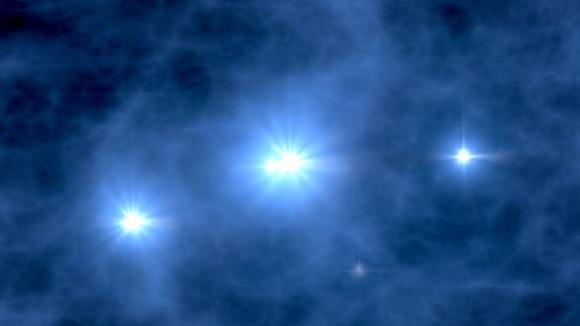
For the next 850 million years or so, these elements came together into monster stars of pure hydrogen and helium. Without heavier elements, they were free to form stars with dozens or even hundreds of times the mass of our own Sun. These are the Population III stars, or the first stars, and we don’t have telescopes powerful enough to see them yet. Astronomers indirectly estimate that those first stars formed about 560 million years after the Big Bang.
Then, those first stars exploded as supernovae, more massive stars formed and they detonated as well. It’s seriously difficult to imagine what that time must have looked like, with stars going off like fireworks. But we know it was so common and so violent that it lit up the whole Universe in an era called reionization. Most of the Universe was hot plasma.
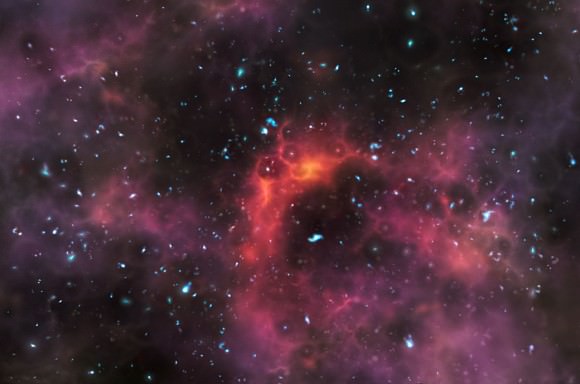
The early Universe was hot and awful, and there weren’t a lot of the heavier elements that life as we know it depends on. Just think about it. You can’t get oxygen without fusion in a star, even multiple generations. Our own Solar System is the result of several generations of supernovae that exploded, seeding our region with heavier and heavier elements.
As I mentioned earlier in the article, the Universe cooled from 4000 kelvin down to 60 kelvin. About 10 million years after the Big Bang, the temperature of the Universe was 100 C, the boiling point of water. And then 7 million years later, it was down to 0 C, the freezing point of water.
This has led astronomers to theorize that for about 7 million years, liquid water was present across the Universe… everywhere. And wherever we find liquid water on Earth, we find life.
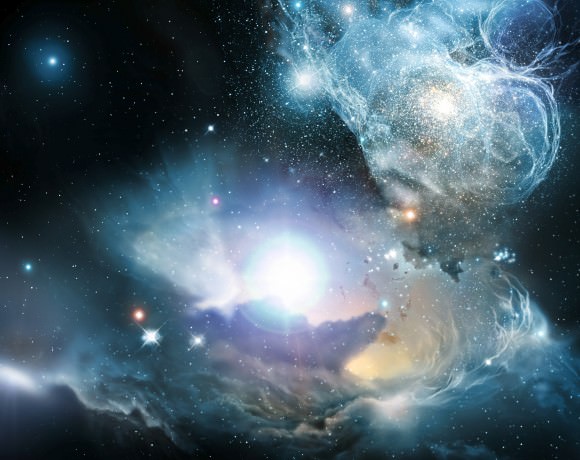
So it’s possible, possible that primitive life could have formed with the Universe was just 10 million years old. The physicist Avi Loeb calls this the habitable Epoch of the Universe. No evidence, but it’s a pretty cool idea to think about.
I always find it absolutely mind bending to think that all around us in every direction is the first light from the Universe. It’s taken 13.8 billion years to reach us, and although we need microwave eyes to actually see it, it’s there, everywhere.
What is the Speed of Light?

Since ancient times, philosophers and scholars have sought to understand light. In addition to trying to discern its basic properties (i.e. what is it made of – particle or wave, etc.) they have also sought to make finite measurements of how fast it travels. Since the late-17th century, scientists have been doing just that, and with increasing accuracy.
In so doing, they have gained a better understanding of light’s mechanics and the important role it plays in physics, astronomy and cosmology. Put simply, light moves at incredible speeds and is the fastest moving thing in the Universe. Its speed is considered a constant and an unbreakable barrier, and is used as a means of measuring distance. But just how fast does it travel?
Speed of Light (c):
Light travels at a constant speed of 1,079,252,848.8 (1.07 billion) km per hour. That works out to 299,792,458 m/s, or about 670,616,629 mph (miles per hour). To put that in perspective, if you could travel at the speed of light, you would be able to circumnavigate the globe approximately seven and a half times in one second. Meanwhile, a person flying at an average speed of about 800 km/h (500 mph), would take over 50 hours to circle the planet just once.
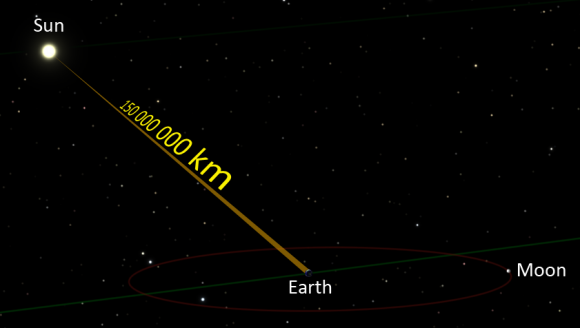
To put that into an astronomical perspective, the average distance from the Earth to the Moon is 384,398.25 km (238,854 miles ). So light crosses that distance in about a second. Meanwhile, the average distance from the Sun to the Earth is ~149,597,886 km (92,955,817 miles), which means that light only takes about 8 minutes to make that journey.
Little wonder then why the speed of light is the metric used to determine astronomical distances. When we say a star like Proxima Centauri is 4.25 light years away, we are saying that it would take – traveling at a constant speed of 1.07 billion km per hour (670,616,629 mph) – about 4 years and 3 months to get there. But just how did we arrive at this highly specific measurement for “light-speed”?
History of Study:
Until the 17th century, scholars were unsure whether light traveled at a finite speed or instantaneously. From the days of the ancient Greeks to medieval Islamic scholars and scientists of the early modern period, the debate went back and forth. It was not until the work of Danish astronomer Øle Rømer (1644-1710) that the first quantitative measurement was made.
In 1676, Rømer observed that the periods of Jupiter’s innermost moon Io appeared to be shorter when the Earth was approaching Jupiter than when it was receding from it. From this, he concluded that light travels at a finite speed, and estimated that it takes about 22 minutes to cross the diameter of Earth’s orbit.
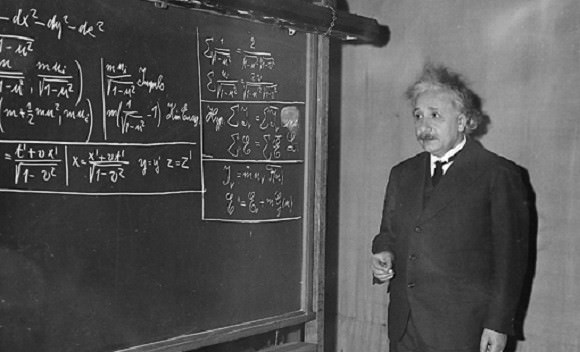
Christiaan Huygens used this estimate and combined it with an estimate of the diameter of the Earth’s orbit to obtain an estimate of 220,000 km/s. Isaac Newton also spoke about Rømer’s calculations in his seminal work Opticks (1706). Adjusting for the distance between the Earth and the Sun, he calculated that it would take light seven or eight minutes to travel from one to the other. In both cases, they were off by a relatively small margin.
Later measurements made by French physicists Hippolyte Fizeau (1819 – 1896) and Léon Foucault (1819 – 1868) refined these measurements further – resulting in a value of 315,000 km/s (192,625 mi/s). And by the latter half of the 19th century, scientists became aware of the connection between light and electromagnetism.
This was accomplished by physicists measuring electromagnetic and electrostatic charges, who then found that the numerical value was very close to the speed of light (as measured by Fizeau). Based on his own work, which showed that electromagnetic waves propagate in empty space, German physicist Wilhelm Eduard Weber proposed that light was an electromagnetic wave.
The next great breakthrough came during the early 20th century/ In his 1905 paper, titled “On the Electrodynamics of Moving Bodies”, Albert Einstein asserted that the speed of light in a vacuum, measured by a non-accelerating observer, is the same in all inertial reference frames and independent of the motion of the source or observer.
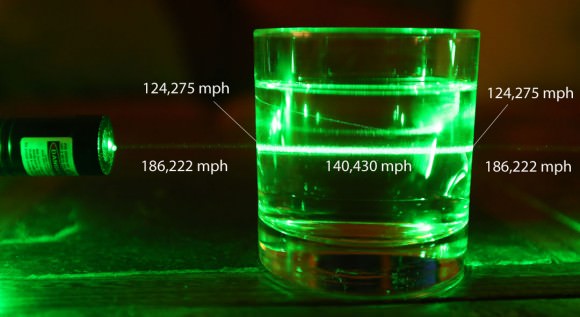
Using this and Galileo’s principle of relativity as a basis, Einstein derived the Theory of Special Relativity, in which the speed of light in vacuum (c) was a fundamental constant. Prior to this, the working consensus among scientists held that space was filled with a “luminiferous aether” that was responsible for its propagation – i.e. that light traveling through a moving medium would be dragged along by the medium.
This in turn meant that the measured speed of the light would be a simple sum of its speed through the medium plus the speed of that medium. However, Einstein’s theory effectively made the concept of the stationary aether useless and revolutionized the concepts of space and time.
Not only did it advance the idea that the speed of light is the same in all inertial reference frames, it also introduced the idea that major changes occur when things move close the speed of light. These include the time-space frame of a moving body appearing to slow down and contract in the direction of motion when measured in the frame of the observer (i.e. time dilation, where time slows as the speed of light approaches).
His observations also reconciled Maxwell’s equations for electricity and magnetism with the laws of mechanics, simplified the mathematical calculations by doing away with extraneous explanations used by other scientists, and accorded with the directly observed speed of light.
During the second half of the 20th century, increasingly accurate measurements using laser inferometers and cavity resonance techniques would further refine estimates of the speed of light. By 1972, a group at the US National Bureau of Standards in Boulder, Colorado, used the laser inferometer technique to get the currently-recognized value of 299,792,458 m/s.
Role in Modern Astrophysics:
Einstein’s theory that the speed of light in vacuum is independent of the motion of the source and the inertial reference frame of the observer has since been consistently confirmed by many experiments. It also sets an upper limit on the speeds at which all massless particles and waves (which includes light) can travel in a vacuum.
One of the outgrowths of this is that cosmologists now treat space and time as a single, unified structure known as spacetime – in which the speed of light can be used to define values for both (i.e. “lightyears”, “light minutes”, and “light seconds”). The measurement of the speed of light has also become a major factor when determining the rate of cosmic expansion.
Beginning in the 1920’s with observations of Lemaitre and Hubble, scientists and astronomers became aware that the Universe is expanding from a point of origin. Hubble also observed that the farther away a galaxy is, the faster it appears to be moving. In what is now referred to as the Hubble Parameter, the speed at which the Universe is expanding is calculated to 68 km/s per megaparsec.
This phenomena, which has been theorized to mean that some galaxies could actually be moving faster than the speed of light, may place a limit on what is observable in our Universe. Essentially, galaxies traveling faster than the speed of light would cross a “cosmological event horizon”, where they are no longer visible to us.
Also, by the 1990’s, redshift measurements of distant galaxies showed that the expansion of the Universe has been accelerating for the past few billion years. This has led to theories like “Dark Energy“, where an unseen force is driving the expansion of space itself instead of objects moving through it (thus not placing constraints on the speed of light or violating relativity).
Along with special and general relativity, the modern value of the speed of light in a vacuum has gone on to inform cosmology, quantum physics, and the Standard Model of particle physics. It remains a constant when talking about the upper limit at which massless particles can travel, and remains an unachievable barrier for particles that have mass.
Perhaps, someday, we will find a way to exceed the speed of light. While we have no practical ideas for how this might happen, the smart money seems to be on technologies that will allow us to circumvent the laws of spacetime, either by creating warp bubbles (aka. the Alcubierre Warp Drive), or tunneling through it (aka. wormholes).
Until that time, we will just have to be satisfied with the Universe we can see, and to stick to exploring the part of it that is reachable using conventional methods.
We have written many articles about the speed of light for Universe Today. Here’s How Fast is the Speed of Light?, How are Galaxies Moving Away Faster than Light?, How Can Space Travel Faster than the Speed of Light?, and Breaking the Speed of Light.
Here’s a cool calculator that lets you convert many different units for the speed of light, and here’s a relativity calculator, in case you wanted to travel nearly the speed of light.
Astronomy Cast also has an episode that addresses questions about the speed of light – Questions Show: Relativity, Relativity, and more Relativity.
Sources:
How Can Space Travel Faster Than The Speed Of Light?
Cosmologists are intellectual time travelers. Looking back over billions of years, these scientists are able to trace the evolution of our Universe in astonishing detail. 13.8 billion years ago, the Big Bang occurred. Fractions of a second later, the fledgling Universe expanded exponentially during an incredibly brief period of time called inflation. Over the ensuing eons, our cosmos has grown to such an enormous size that we can no longer see the other side of it.
But how can this be? If light’s velocity marks a cosmic speed limit, how can there possibly be regions of spacetime whose photons are forever out of our reach? And even if there are, how do we know that they exist at all?
The Expanding Universe
Like everything else in physics, our Universe strives to exist in the lowest possible energy state possible. But around 10-36 seconds after the Big Bang, inflationary cosmologists believe that the cosmos found itself resting instead at a “false vacuum energy” – a low-point that wasn’t really a low-point. Seeking the true nadir of vacuum energy, over a minute fraction of a moment, the Universe is thought to have ballooned by a factor of 1050.
Since that time, our Universe has continued to expand, but at a much slower pace. We see evidence of this expansion in the light from distant objects. As photons emitted by a star or galaxy propagate across the Universe, the stretching of space causes them to lose energy. Once the photons reach us, their wavelengths have been redshifted in accordance with the distance they have traveled.
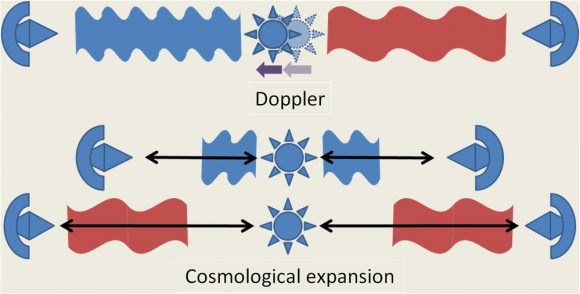
This is why cosmologists speak of redshift as a function of distance in both space and time. The light from these distant objects has been traveling for so long that, when we finally see it, we are seeing the objects as they were billions of years ago.
The Hubble Volume
Redshifted light allows us to see objects like galaxies as they existed in the distant past; but we cannot see all events that occurred in our Universe during its history. Because our cosmos is expanding, the light from some objects is simply too far away for us ever to see.
The physics of that boundary rely, in part, on a chunk of surrounding spacetime called the Hubble volume. Here on Earth, we define the Hubble volume by measuring something called the Hubble parameter (H0), a value that relates the apparent recession speed of distant objects to their redshift. It was first calculated in 1929, when Edwin Hubble discovered that faraway galaxies appeared to be moving away from us at a rate that was proportional to the redshift of their light.
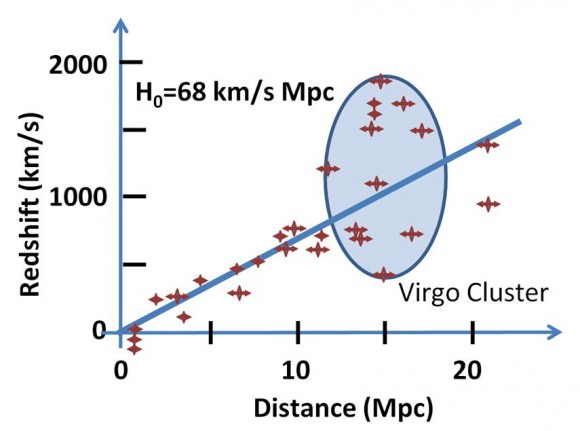
Dividing the speed of light by H0, we get the Hubble volume. This spherical bubble encloses a region where all objects move away from a central observer at speeds less than the speed of light. Correspondingly, all objects outside of the Hubble volume move away from the center faster than the speed of light.
Yes, “faster than the speed of light.” How is this possible?
The Magic of Relativity
The answer has to do with the difference between special relativity and general relativity. Special relativity requires what is called an “inertial reference frame” – more simply, a backdrop. According to this theory, the speed of light is the same when compared in all inertial reference frames. Whether an observer is sitting still on a park bench on planet Earth or zooming past Neptune in a futuristic high-velocity rocketship, the speed of light is always the same. A photon always travels away from the observer at 300,000,000 meters per second, and he or she will never catch up.
General relativity, however, describes the fabric of spacetime itself. In this theory, there is no inertial reference frame. Spacetime is not expanding with respect to anything outside of itself, so the the speed of light as a limit on its velocity doesn’t apply. Yes, galaxies outside of our Hubble sphere are receding from us faster than the speed of light. But the galaxies themselves aren’t breaking any cosmic speed limits. To an observer within one of those galaxies, nothing violates special relativity at all. It is the space in between us and those galaxies that is rapidly proliferating and stretching exponentially.
The Observable Universe
Now for the next bombshell: The Hubble volume is not the same thing as the observable Universe.
To understand this, consider that as the Universe gets older, distant light has more time to reach our detectors here on Earth. We can see objects that have accelerated beyond our current Hubble volume because the light we see today was emitted when they were within it.
Strictly speaking, our observable Universe coincides with something called the particle horizon. The particle horizon marks the distance to the farthest light that we can possibly see at this moment in time – photons that have had enough time to either remain within, or catch up to, our gently expanding Hubble sphere.
And just what is this distance? A little more than 46 billion light years in every direction – giving our observable Universe a diameter of approximately 93 billion light years, or more than 500 billion trillion miles.
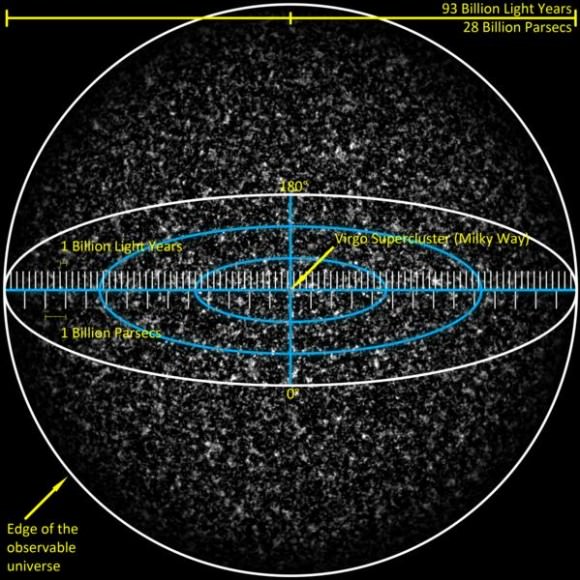
(A quick note: the particle horizon is not the same thing as the cosmological event horizon. The particle horizon encompasses all the events in the past that we can currently see. The cosmological event horizon, on the other hand, defines a distance within which a future observer will be able to see the then-ancient light our little corner of spacetime is emitting today.
In other words, the particle horizon deals with the distance to past objects whose ancient light that we can see today; the cosmological event horizon deals with the distance that our present-day light that will be able to travel as faraway regions of the Universe accelerate away from us.)
Dark Energy
Thanks to the expansion of the Universe, there are regions of the cosmos that we will never see, even if we could wait an infinite amount of time for their light to reach us. But what about those areas just beyond the reaches of our present-day Hubble volume? If that sphere is also expanding, will we ever be able to see those boundary objects?
This depends on which region is expanding faster – the Hubble volume or the parts of the Universe just outside of it. And the answer to that question depends on two things: 1) whether H0 is increasing or decreasing, and 2) whether the Universe is accelerating or decelerating. These two rates are intimately related, but they are not the same.
In fact, cosmologists believe that we are actually living at a time when H0 is decreasing; but because of dark energy, the velocity of the Universe’s expansion is increasing.
That may sound counterintuitive, but as long as H0 decreases at a slower rate than that at which the Universe’s expansion velocity is increasing, the overall movement of galaxies away from us still occurs at an accelerated pace. And at this moment in time, cosmologists believe that the Universe’s expansion will outpace the more modest growth of the Hubble volume.
So even though our Hubble volume is expanding, the influence of dark energy appears to provide a hard limit to the ever-increasing observable Universe.
Our Earthly Limitations
Cosmologists seem to have a good handle on deep questions like what our observable Universe will someday look like and how the expansion of the cosmos will change. But ultimately, scientists can only theorize the answers to questions about the future based on their present-day understanding of the Universe. Cosmological timescales are so unimaginably long that it is impossible to say much of anything concrete about how the Universe will behave in the future. Today’s models fit the current data remarkably well, but the truth is that none of us will live long enough to see whether the predictions truly match all of the outcomes.
Disappointing? Sure. But totally worth the effort to help our puny brains consider such mind-bloggling science – a reality that, as usual, is just plain stranger than fiction.
Special Relativity May Answer Faster-than-Light Neutrino Mystery
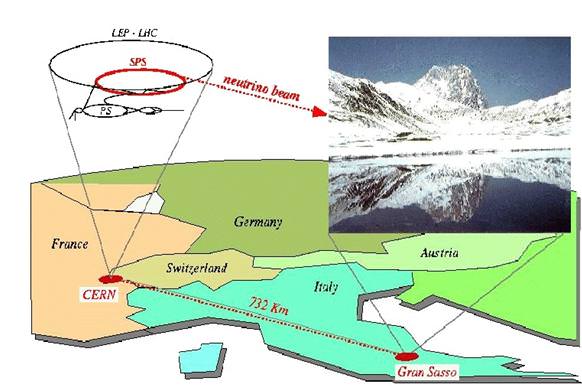
[/caption]
Oh, yeah. Moving faster than the speed of light has been the hot topic in the news and OPERA has been the key player. In case you didn’t know, the experiment unleashed some particles at CERN, close to Geneva. It wasn’t the production that caused the buzz, it was the revelation they arrived at the Gran Sasso Laboratory in Italy around 60 nanoseconds sooner than they should have. Sooner than the speed of light allows!
Since the announcement, the physics world has been on fire, producing more than 80 papers – each with their own opinion. While some tried to explain the effect, others discredited it. The overpowering concensus was the OPERA team simply must have forgotten one critical element. On October 14, 2011, Ronald van Elburg at the University of Groningen in the Netherlands put forth his own statement – one that provides a persuasive point that he may have found the error in the calculations.
To get a clearer picture, the distance the neutrinos traveled is straightforward. They began in CERN and were measured via global positioning systems. However, the Gran Sasso Laboratory is located beneath the Earth under a kilometre-high mountain. Regardless, the OPERA team took this into account and provided an accurate distance measurement of 730 km to within tolerances of 20 cm. The neutrino flight time is then measured by using clocks at the opposing ends, with the team knowing exactly when the particles left and when they landed.
But were the clocks perfectly synchronized?
Keeping time is again the domain of the GPS satellites which each broadcasting a highly accurate time signal from orbit some 20,000km overhead. But is it possible the team overlooked the amount of time it took for the satellite signals to return to Earth? In his statement, van Elburg says there is one effect that the OPERA team seems to have overlooked: the relativistic motion of the GPS clocks.
Sure, radio waves travel at the speed of light, so what difference does the satellite position make? The truth is, it doesn’t.. but the time of flight does. Here we have a scenario where one clock is on the ground while the other is orbiting. If they are moving relative to one another, this calculation needs to be included in the findings. The orbiting probes are positioned from West to East in a plane inclined at 55 degrees to the equator… almost directly in line with the neutrino flight path. This means the clock on the GPS is seeing the neutrino source and detector as changing.
“From the perspective of the clock, the detector is moving towards the source and consequently the distance travelled by the particles as observed from the clock is shorter,” says van Elburg.
According to the news source, he means shorter than the distance measured in the reference frame on the ground and the OPERA team overlooks this because it thinks of the clocks as on the ground not in orbit. Van Elburg calculates that it should cause the neutrinos to arrive 32 nanoseconds early. But this must be doubled because the same error occurs at each end of the experiment. So the total correction is 64 nanoseconds, almost exactly what the OPERA team observes.
Is this the final answer for traveling faster than the speed of light? No. It’s just another possible answer to explain a new riddle… and a confirmation of a new revelation.
Original Story Source: Technology Review News Release. For Further Reading: Can apparent superluminal neutrino speeds be explained as a quantum weak measurement?.
Faster Than The Speed Of Light… OPERA Update
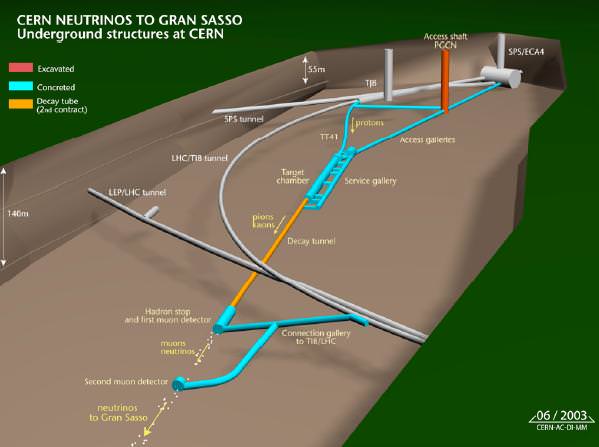
[/caption]
A few days ago, the physics world was turned upside down at the announcement of “faster than the speed of light”. The mighty neutrino has struck again by breaking the cosmic speed limit and traveling at a velocity 20 parts per million above light speed. To absolutely verify this occurrence, collaboration is needed from different sources and we’re here to give you the latest update.
“This result comes as a complete surprise,” said OPERA spokesperson, Antonio Ereditato of the University of Bern. “After many months of studies and cross checks we have not found any instrumental effect that could explain the result of the measurement. While OPERA researchers will continue their studies, we are also looking forward to independent measurements to fully assess the nature of this observation.”
Since the OPERA measurements go against everything we think we know, it’s more important than ever to verify its findings through independent research.
“When an experiment finds an apparently unbelievable result and can find no artifact of the measurement to account for it, it’s normal procedure to invite broader scrutiny, and this is exactly what the OPERA collaboration is doing, it’s good scientific practice,” said CERN Research Director Sergio Bertolucci. “If this measurement is confirmed, it might change our view of physics, but we need to be sure that there are no other, more mundane, explanations. That will require independent measurements.”
To get the job done, the OPERA Collaboration joined forces with CERN metrology experts and other facilities to establish absolute calibrations. There cannot be any error margin in parameters between the source and detector distances – and the neutrino’s flight time. In this circumstance, the measurements of the initial source of the neutrino beam and OPERA has an uncertainty value of 20 cm over the 730 km. The neutrino flight time has an accuracy of less than 10 nanoseconds, and was confirmed through the use of highly regarded GPS equipment and an atomic clock. Every care was given to ensure precision.
“We have established synchronization between CERN and Gran Sasso that gives us nanosecond accuracy, and we’ve measured the distance between the two sites to 20 centimetres,” said Dario Autiero, the CNRS researcher who will give this afternoon’s seminar. “Although our measurements have low systematic uncertainty and high statistical accuracy, and we place great confidence in our results, we’re looking forward to comparing them with those from other experiments.”
“The potential impact on science is too large to draw immediate conclusions or attempt physics interpretations. My first reaction is that the neutrino is still surprising us with its mysteries.” said Ereditato. “Today’s seminar is intended to invite scrutiny from the broader particle physics community.”
Original Story Source: CERN Press Release. For Further Reading: Measurement of the neutrino velocity with the OPERA detector in the CNGS beam.
Breaking the Speed of Light

[/caption]
It’s been a tenet of the standard model of physics for over a century. The speed of light is a unwavering and unbreakable barrier, at least by any form of matter and energy we know of. Nothing in our Universe can travel faster than 299,792 km/s (186,282 miles per second), not even – as the term implies – light itself. It’s the universal constant, the “c” in Einstein’s E = mc2, a cosmic speed limit that can’t be broken.
That is, until now.
An international team of scientists at the Gran Sasso research facility outside of Rome announced today that they have clocked neutrinos traveling faster than the speed of light. The neutrinos, subatomic particles with very little mass, were contained within beams emitted from CERN 730 km (500 miles) away in Switzerland. Over a period of three years, 15,000 neutrino beams were fired from CERN at special detectors located deep underground at Gran Sasso. Where light would have made the trip in 2.4 thousandths of a second, the neutrinos made it there 60 nanoseconds faster – that’s 60 billionths of a second – a tiny difference to us but a huge difference to particle physicists!
The implications of such a discovery are staggering, as it would effectively undermine Einstein’s theory of relativity and force a rewrite of the Standard Model of physics.

“We are shocked,” said project spokesman and University of Bern physicist Antonio Ereditato.
“We have high confidence in our results. We have checked and rechecked for anything that could have distorted our measurements but we found nothing. We now want colleagues to check them independently.”
Neutrinos are created naturally from the decay of radioactive materials and from reactions that occur inside stars. Neutrinos are constantly zipping through space and can pass through solid material easily with little discernible effect… as you’ve been reading this billions of neutrinos have already passed through you!
The experiment, called OPERA (Oscillation Project with Emulsion-tRacking Apparatus) is located in Italy’s Gran Sasso facility 1,400 meters (4,593 feet) underground and uses a complex array of electronics and photographic plates to detect the particle beams. Its subterranean location helps prevent experiment contamination from other sources of radiation, such as cosmic rays. Over 750 scientists from 22 countries around the world work there.
Ereditato is confident in the results as they have been consistently measured in over 16,000 events over the past two years. Still, other experiments are being planned elsewhere in an attempt to confirm these remarkable findings. If they are confirmed, we may be looking at a literal breakdown of the modern rules of physics as we know them!
“We have high confidence in our results,” said Ereditato. “We have checked and rechecked for anything that could have distorted our measurements but we found nothing. We now want colleagues to check them independently.”
A preprint of the OPERA results will be posted on the physics website ArXiv.org.
Read more on the Nature article here and on Reuters.com.
UPDATE: The OPERA team paper can be found here.

